Qian Ma
A Multi-view Divergence-Convergence Feature Augmentation Framework for Drug-related Microbes Prediction
Jun 23, 2025Abstract:In the study of drug function and precision medicine, identifying new drug-microbe associations is crucial. However, current methods isolate association and similarity analysis of drug and microbe, lacking effective inter-view optimization and coordinated multi-view feature fusion. In our study, a multi-view Divergence-Convergence Feature Augmentation framework for Drug-related Microbes Prediction (DCFA_DMP) is proposed, to better learn and integrate association information and similarity information. In the divergence phase, DCFA_DMP strengthens the complementarity and diversity between heterogeneous information and similarity information by performing Adversarial Learning method between the association network view and different similarity views, optimizing the feature space. In the convergence phase, a novel Bidirectional Synergistic Attention Mechanism is proposed to deeply synergize the complementary features between different views, achieving a deep fusion of the feature space. Moreover, Transformer graph learning is alternately applied on the drug-microbe heterogeneous graph, enabling each drug or microbe node to focus on the most relevant nodes. Numerous experiments demonstrate DCFA_DMP's significant performance in predicting drug-microbe associations. It also proves effectiveness in predicting associations for new drugs and microbes in cold start experiments, further confirming its stability and reliability in predicting potential drug-microbe associations.
How to Backdoor the Knowledge Distillation
Apr 30, 2025Abstract:Knowledge distillation has become a cornerstone in modern machine learning systems, celebrated for its ability to transfer knowledge from a large, complex teacher model to a more efficient student model. Traditionally, this process is regarded as secure, assuming the teacher model is clean. This belief stems from conventional backdoor attacks relying on poisoned training data with backdoor triggers and attacker-chosen labels, which are not involved in the distillation process. Instead, knowledge distillation uses the outputs of a clean teacher model to guide the student model, inherently preventing recognition or response to backdoor triggers as intended by an attacker. In this paper, we challenge this assumption by introducing a novel attack methodology that strategically poisons the distillation dataset with adversarial examples embedded with backdoor triggers. This technique allows for the stealthy compromise of the student model while maintaining the integrity of the teacher model. Our innovative approach represents the first successful exploitation of vulnerabilities within the knowledge distillation process using clean teacher models. Through extensive experiments conducted across various datasets and attack settings, we demonstrate the robustness, stealthiness, and effectiveness of our method. Our findings reveal previously unrecognized vulnerabilities and pave the way for future research aimed at securing knowledge distillation processes against backdoor attacks.
Enhancing Adversarial Example Detection Through Model Explanation
Mar 12, 2025



Abstract:Adversarial examples are a major problem for machine learning models, leading to a continuous search for effective defenses. One promising direction is to leverage model explanations to better understand and defend against these attacks. We looked at AmI, a method proposed by a NeurIPS 2018 spotlight paper that uses model explanations to detect adversarial examples. Our study shows that while AmI is a promising idea, its performance is too dependent on specific settings (e.g., hyperparameter) and external factors such as the operating system and the deep learning framework used, and such drawbacks limit AmI's practical usage. Our findings highlight the need for more robust defense mechanisms that are effective under various conditions. In addition, we advocate for a comprehensive evaluation framework for defense techniques.
Baichuan4-Finance Technical Report
Dec 17, 2024



Abstract:Large language models (LLMs) have demonstrated strong capabilities in language understanding, generation, and reasoning, yet their potential in finance remains underexplored due to the complexity and specialization of financial knowledge. In this work, we report the development of the Baichuan4-Finance series, including a comprehensive suite of foundational Baichuan4-Finance-Base and an aligned language model Baichuan4-Finance, which are built upon Baichuan4-Turbo base model and tailored for finance domain. Firstly, we have dedicated significant effort to building a detailed pipeline for improving data quality. Moreover, in the continual pre-training phase, we propose a novel domain self-constraint training strategy, which enables Baichuan4-Finance-Base to acquire financial knowledge without losing general capabilities. After Supervised Fine-tuning and Reinforcement Learning from Human Feedback and AI Feedback, the chat model Baichuan4-Finance is able to tackle various financial certification questions and real-world scenario applications. We evaluate Baichuan4-Finance on many widely used general datasets and two holistic financial benchmarks. The evaluation results show that Baichuan4-Finance-Base surpasses almost all competitive baselines on financial tasks by significant margins without sacrificing performance on general LLM benchmarks. At the same time, Baichuan4-Finance demonstrates even more impressive performance on financial application scenarios, showcasing its potential to foster community innovation in the financial LLM field.
Do Neural Scaling Laws Exist on Graph Self-Supervised Learning?
Aug 20, 2024



Abstract:Self-supervised learning~(SSL) is essential to obtain foundation models in NLP and CV domains via effectively leveraging knowledge in large-scale unlabeled data. The reason for its success is that a suitable SSL design can help the model to follow the neural scaling law, i.e., the performance consistently improves with increasing model and dataset sizes. However, it remains a mystery whether existing SSL in the graph domain can follow the scaling behavior toward building Graph Foundation Models~(GFMs) with large-scale pre-training. In this study, we examine whether existing graph SSL techniques can follow the neural scaling behavior with the potential to serve as the essential component for GFMs. Our benchmark includes comprehensive SSL technique implementations with analysis conducted on both the conventional SSL setting and many new settings adopted in other domains. Surprisingly, despite the SSL loss continuously decreasing, no existing graph SSL techniques follow the neural scaling behavior on the downstream performance. The model performance only merely fluctuates on different data scales and model scales. Instead of the scales, the key factors influencing the performance are the choices of model architecture and pretext task design. This paper examines existing SSL techniques for the feasibility of Graph SSL techniques in developing GFMs and opens a new direction for graph SSL design with the new evaluation prototype. Our code implementation is available online to ease reproducibility on https://github.com/GraphSSLScaling/GraphSSLScaling.
Holography inspired self-controlled reconfigurable intelligent surface
Mar 24, 2024



Abstract:Among various promising candidate technologies for the sixth-generation (6G) wireless communications, recent advances in microwave metasurfaces have sparked a new research area of reconfigurable intelligent surfaces (RISs). By controllably reprogramming the wireless propagation channel, RISs are envisioned to achieve low-cost wireless capacity boosting, coverage extension, and enhanced energy efficiency. To reprogram the channel, each meta-atom on RIS needs an external control signal, which is usually generated by base station (BS). However, BS-controlled RISs require complicated control cables, which hamper their massive deployments. Here, we eliminate the need for BS control by proposing a self-controlled RIS (SC-RIS), which is inspired by the optical holography principle. Different from the existing BS-controlled RISs, each meta-atom of SC-RIS is integrated with an additional power detector for holographic recording. By applying the classical Fourier-transform processing to the measured hologram, SC-RIS is capable of retrieving the user's channel state information required for beamforming, thus enabling autonomous RIS beamforming without control cables. Owing to this WiFi-like plug-and-play capability without the BS control, SC-RISs are expected to enable easy and massive deployments in the future 6G systems.
Overcoming Pitfalls in Graph Contrastive Learning Evaluation: Toward Comprehensive Benchmarks
Feb 24, 2024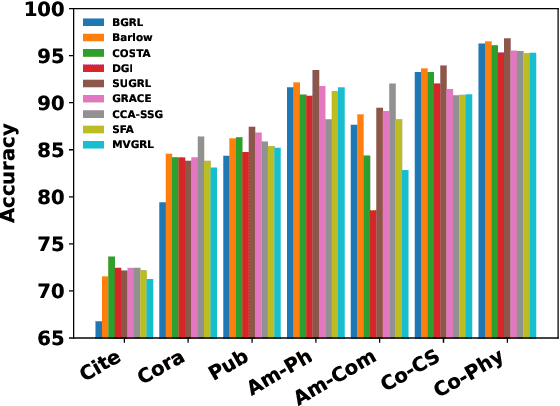
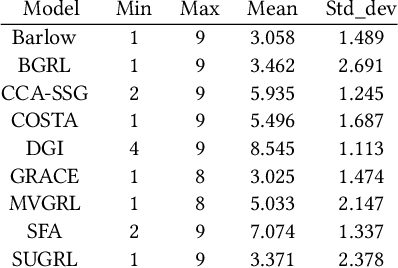
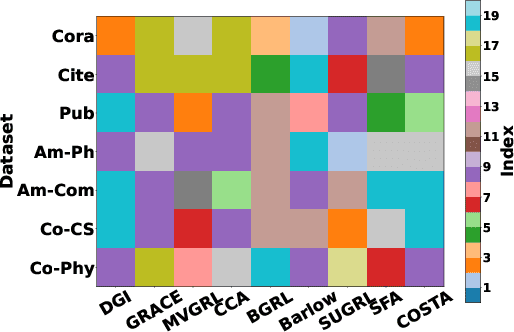
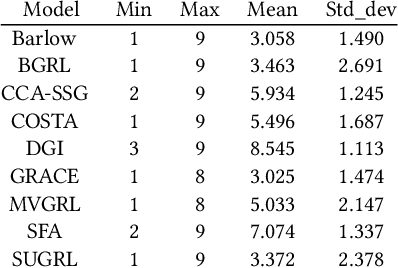
Abstract:The rise of self-supervised learning, which operates without the need for labeled data, has garnered significant interest within the graph learning community. This enthusiasm has led to the development of numerous Graph Contrastive Learning (GCL) techniques, all aiming to create a versatile graph encoder that leverages the wealth of unlabeled data for various downstream tasks. However, the current evaluation standards for GCL approaches are flawed due to the need for extensive hyper-parameter tuning during pre-training and the reliance on a single downstream task for assessment. These flaws can skew the evaluation away from the intended goals, potentially leading to misleading conclusions. In our paper, we thoroughly examine these shortcomings and offer fresh perspectives on how GCL methods are affected by hyper-parameter choices and the choice of downstream tasks for their evaluation. Additionally, we introduce an enhanced evaluation framework designed to more accurately gauge the effectiveness, consistency, and overall capability of GCL methods.
Multiperson Detection and Vital-Sign Sensing Empowered by Space-Time-Coding RISs
Jan 15, 2024Abstract:Passive human sensing using wireless signals has attracted increasing attention due to its superiorities of non-contact and robustness in various lighting conditions. However, when multiple human individuals are present, their reflected signals could be intertwined in the time, frequency and spatial domains, making it challenging to separate them. To address this issue, this paper proposes a novel system for multiperson detection and monitoring of vital signs (i.e., respiration and heartbeat) with the assistance of space-time-coding (STC) reconfigurable intelligent metasurfaces (RISs). Specifically, the proposed system scans the area of interest (AoI) for human detection by using the harmonic beams generated by the STC RIS. Simultaneously, frequencyorthogonal beams are assigned to each detected person for accurate estimation of their respiration rate (RR) and heartbeat rate (HR). Furthermore, to efficiently extract the respiration signal and the much weaker heartbeat signal, we propose an improved variational mode decomposition (VMD) algorithm to accurately decompose the complex reflected signals into a smaller number of intrinsic mode functions (IMFs). We build a prototype to validate the proposed multiperson detection and vital-sign monitoring system. Experimental results demonstrate that the proposed system can simultaneously monitor the vital signs of up to four persons. The errors of RR and HR estimation using the improved VMD algorithm are below 1 RPM (respiration per minute) and 5 BPM (beats per minute), respectively. Further analysis reveals that the flexible beam controlling mechanism empowered by the STC RIS can reduce the noise reflected from other irrelative objects on the physical layer, and improve the signal-to-noise ratio of echoes from the human chest.
Passive Human Sensing Enhanced by Reconfigurable Intelligent Surface: Opportunities and Challenges
Nov 14, 2023



Abstract:Reconfigurable intelligent surfaces (RISs) have flexible and exceptional performance in manipulating electromagnetic waves and customizing wireless channels. These capabilities enable them to provide a plethora of valuable activity-related information for promoting wireless human sensing. In this article, we present a comprehensive review of passive human sensing using radio frequency signals with the assistance of RISs. Specifically, we first introduce fundamental principles and physical platform of RISs. Subsequently, based on the specific applications, we categorize the state-of-the-art human sensing techniques into three types, including human imaging,localization, and activity recognition. Meanwhile, we would also investigate the benefits that RISs bring to these applications. Furthermore, we explore the application of RISs in human micro-motion sensing, and propose a vital signs monitoring system enhanced by RISs. Experimental results are presented to demonstrate the promising potential of RISs in sensing vital signs for manipulating individuals. Finally, we discuss the technical challenges and opportunities in this field.
Rethinking Sensors Modeling: Hierarchical Information Enhanced Traffic Forecasting
Sep 20, 2023

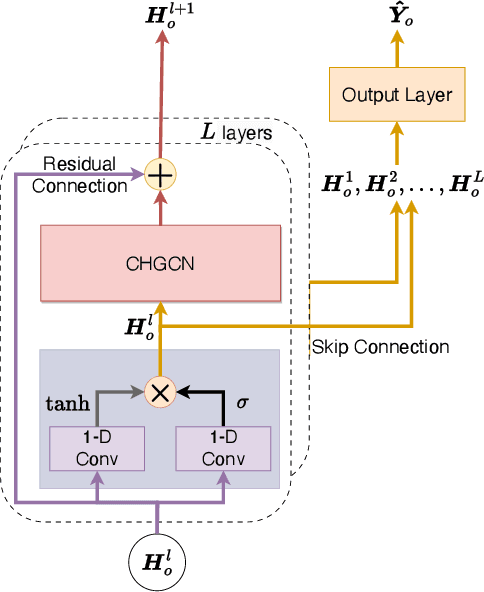

Abstract:With the acceleration of urbanization, traffic forecasting has become an essential role in smart city construction. In the context of spatio-temporal prediction, the key lies in how to model the dependencies of sensors. However, existing works basically only consider the micro relationships between sensors, where the sensors are treated equally, and their macroscopic dependencies are neglected. In this paper, we argue to rethink the sensor's dependency modeling from two hierarchies: regional and global perspectives. Particularly, we merge original sensors with high intra-region correlation as a region node to preserve the inter-region dependency. Then, we generate representative and common spatio-temporal patterns as global nodes to reflect a global dependency between sensors and provide auxiliary information for spatio-temporal dependency learning. In pursuit of the generality and reality of node representations, we incorporate a Meta GCN to calibrate the regional and global nodes in the physical data space. Furthermore, we devise the cross-hierarchy graph convolution to propagate information from different hierarchies. In a nutshell, we propose a Hierarchical Information Enhanced Spatio-Temporal prediction method, HIEST, to create and utilize the regional dependency and common spatio-temporal patterns. Extensive experiments have verified the leading performance of our HIEST against state-of-the-art baselines. We publicize the code to ease reproducibility.
 Add to Chrome
Add to Chrome Add to Firefox
Add to Firefox Add to Edge
Add to Edge